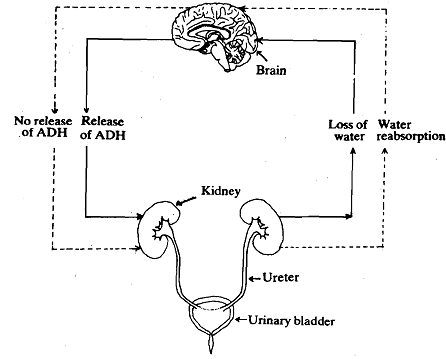Systems view of life:
Evolution has given rise to various types of life forms from single celled bacteria to organisms as complex as a human being. It may interest you to know, that even the simplest of these organisms is able to carry out various life processes like, taking in food, excreting waste material, reacting to stimuli and reproducing offsprings. It is able to survive in varied environments. Let us see how an organism is able todo this.
The characteristics, which we recognize as life, are in fact an expression of the coordinated working of various parts in the organism. Various parts in an organism, whether plant or animal are not haphazardly put together but are organised into systems. A system is a set of some specific inter-related parts which are organized as one unit for some purpose. The parts work together and the entire combination forms one unit. A car producing company, which is organized to produce transport vehicles can be viewed as a system too. For the effective functioning of the company, all of its parts, such as the department that purchases raw materials, the factory, the management and the sales department must work in unison.

An animal or a plant is also made up of numerous parts which represent a well defined system. For example, in an animal body, the parts concerned with the in-take of food and digesting it, the bones arranged as a skeleton to support the body, the heart circulating blood to different parts of the body through the arteries and veins and the brain receiving signals and giving orders of various kinds together compose the system. The assemblage of all plants and animals in an environment provided by each other as well as by the land, air and water works collectively. The way these diverse forms of life depend on each other makes one imagine this planet itself as a huge system. Looking at it in another way, the life and environment of the earth are a well ccwrdinatcd system, within which there are sub-systems like individual organisms. And within each of these sub-systems, a single plant or animal, one would find a complex multicellular system. Similarly, industrial, agricultural cr educational systems can be visualised as the sub-systems in the society.
Organic systems maintain themselves in a given composite form and function. For example, a cat remains a cat, it prowls for food, it may lay kittens, but its internal system functions on the basis of physical principles with stability. How is this stability maintained by a system? Let us take a specific example; how does a man or woman maintain this internal stability while the environment around them changes. For instance, how do they maintain a fixed temperature of 370C, or the composition of their blood or the blood pressure? It has been found that all organisms possess a kind of information and control network which directs them to adjust to various situations for survival, e.g., if you touch a snail, it withdraws into its shell. This is a kind of information and control device for protecting its life. If you sit in the Sun and you feel hot, a signal which is internally generated causes perspiration and produces cooling by evaporation of the sweat. This is another example of information and control for maintaining a fixed body temperature. You will find that all organisms possess a network of information and control which may be very simple or at times quite complicated. Without it, neither the survival of an organism nor its existence in a stable physical condition is possible. A whole science of "cybernetics" has developed to study information and control in a generai way. This is because, even machines have to be .so designed as to work with stability. You must be familiar with a device called a voltage regulator which is used with a television set or a refrigerator. If at any time the voltage becomes higher than a fixed'value the voltage regulator brings it back to that value. Thus, the voltage suppliedto the TV or refrigerator remains stable.